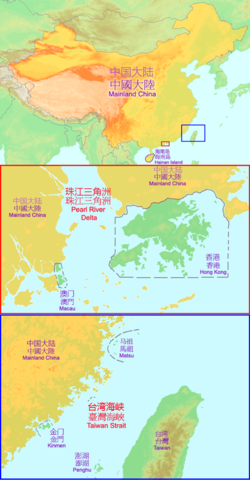Legal uses
Inland China
On 30 December 1954,the Supreme People's Court of the People's Republic of China addressed a marital issue between a spouse residing in Inland and another residing in Hong Kong or Macau. The court used the term "Inland" in its official response,"Reply of the Supreme People's Court Regarding the Handling Opinions on Marital Issues with One Spouse Residing in Inland and the Other in Hong Kong or Macau." This terminology arose from a divorce case between a person from Hong Kong and another from Zhoushan. [40]
On 6 December 1984,in a reply by the Supreme People's Court titled "Reply of the Supreme People's Court on the Issue of Whether Civil Cases Involving Hong Kong and Macau Compatriots Holding 'British National Overseas Passports' Issued by the Hong Kong British Authorities and Identity Cards Issued by the Macau Portuguese Authorities in Inland Chinese People's Courts Should Be Treated as Foreign-Related Cases," it was pointed out that holders of such documents are considered Chinese citizens,not recognizing them as having British or Portuguese nationality;hence their civil cases in Inland Chinese courts should not be treated as foreign-related cases. [41]
On 30 June 2012,the Eleventh National People's Congress passed Article 89 of the "Exit and Entry Administration Law of the People's Republic of China," which states:"Exiting refers to traveling from Inland China to other countries or regions,from Inland China to the Hong Kong Special Administrative Region,the Macau Special Administrative Region,or from the Mainland China to the Taiwan region". [42] This law symmetrically aligns "Inland China" with the Hong Kong and Macau Special Administrative Regions, [42] and in English versions,both are uniformly translated as "Chinese Mainland". [43]
Additionally,the term "Inland residents" is commonly used in contexts related to immigration control,tourism,and marriage,such as individual travel from Hong Kong and Macau,and Inland Travel Permits for Hong Kong and Macau residents. [44] [45] [46] [47]
Hong Kong
In 1997,the Standing Committee of the National People's Congress (NPC) passed the "Decision of the Standing Committee of the National People's Congress on Handling the Existing Laws of Hong Kong in Accordance with Article 160 of the Basic Law of the Hong Kong Special Administrative Region of the People's Republic of China",which required that any references in Hong Kong laws to "Mainland","Taiwan","Hong Kong",and "Macau" should be interpreted as referring to parts of the People's Republic of China. [48] The Hong Kong Interpretation and General Clauses Ordinance stipulates that "'China' refers to the People's Republic of China",and "'the People's Republic of China' includes the Hong Kong and Macau Special Administrative Regions". [49]
In 2003,the Ministry of Commerce and the Financial Secretary of Hong Kong signed the "Closer Economic Partnership Arrangement (CEPA) between Inland and Hong Kong" defining "Inland" as "all the tariff territory of the People's Republic of China". [36] [50]
After Hong Kong's return in 1997,the Hong Kong Special Administrative Region government began to frequently use the term "Inland" in official documents and press releases,replacing terms commonly used during the British colonial period such as "China" or "Chinese Mainland". In Hong Kong laws,"Inland" is defined as any part of China except for Hong Kong and Macau. For example,Hong Kong's Air Pollution Control (Ocean Going Vessels) (Fuel at Berth) Regulation,Cap 311AA,specifies that "Inland means any part of China,but excludes Hong Kong and Macau." [51] The Guangzhou-Shenzhen-Hong Kong Express Rail Link (Co-location) Ordinance,Cap 632,defines "Inland" as "parts of China other than Hong Kong and Macau". [51]
On 1 April 2006,the "Inland Affairs Liaison Office",under the Constitutional Affairs Bureau,was established,and on 1 July 2007,during the administration of Donald Tsang,it was renamed the "Constitutional and Inland Affairs Bureau". [52]
Macau
In 1999,the Standing Committee of the National People's Congress (NPC) passed the "Decision of the Standing Committee of the National People's Congress on Handling the Existing Laws of Macau in Accordance with Article 145 of the Basic Law of the Macau Special Administrative Region of the People's Republic of China." This decision required that any references in Macau's laws that mentioned Inland China,Taiwan,Hong Kong,and Macau,either individually or together,should be interpreted as referring to parts of the People's Republic of China. [53] Law No. 1/1999 of Macau,also known as the "Reunification Law",restated relevant parts of the decision in its Annex IV. [54]
In 2003,the Ministry of Commerce and Macau's Secretary for Economy and Finance signed the "Closer Economic Partnership Arrangement (CEPA) between Inland and Macau" which defined "Inland" as "all the tariff territory of the People's Republic of China". [55]
After the handover in 1999,the Macau Special Administrative Region government began to use the term "Inland" extensively in official documents and press releases,replacing the terms commonly used during the Portuguese administration. In Macau's laws and international treaties where the term "international" is involved,this generally excludes Inland China and Hong Kong. For example,in the "Air Services Agreement between the Government of the Macau Special Administrative Region of the People's Republic of China and the Government of the United Kingdom of Great Britain and Northern Ireland," it is stipulated that "locations in Inland China and Hong Kong shall not be used as intermediate or beyond points." [56]
Usage in entertainment industry
In order to differentiate from the entertainment industries of Europe,America,Taiwan,Japan,Korea,and Hong Kong,the entertainment industry in Inland China is often referred to as the "Inland entertainment industry" or simply "Inland entertainment". Artists who have developed their careers within the People's Republic of China are also referred to as "Inland artists". [57]



